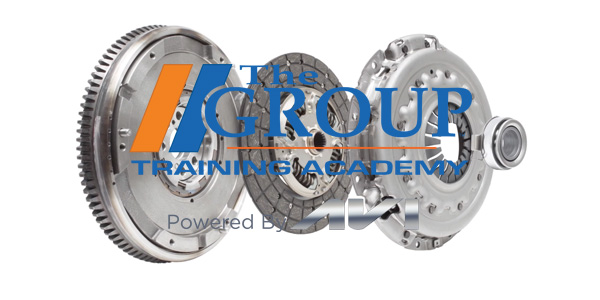MAJOR COMPONENTS & FUNCTIONS
* Transmission or transaxle — The gear box that multiplies engine torque to the rest of the drivetrain. Most manuals today have five or six speeds, with the top gear being an overdrive ratio. Transmissions are used with most rear wheel drive (RWD) vehicles while transaxles are used with most front-wheel drive (FWD) cars. A transaxle also contains the differential.
* Clutch — Connects the engine to the transmission or transaxle. The clutch is released by depressing the clutch pedal. This is necessary when shifting gears or when stopping the vehicle. There are two basic types of clutches: diaphragm and coil spring. The clutch has a stamped steel cover, either a single large diaphragm spring or a series of 9 to 12 coil springs, and a cast iron pressure plate. The clutch cover is bolted to the flywheel, and the spring(s) push against the pressure plate.
When the clutch is engaged, the pressure plate holds the clutch disc tightly against the flywheel. This causes the clutch disc to rotate and drive the transmission input shaft. When the clutch is depressed, the pressure plate is pulled back away from the flywheel allowing the clutch disc to slip or spin freely.
* Clutch disc — A flat steel plate with friction facings on both sides that is located between the clutch and flywheel. The clutch disc has a splined hub that turns that rides on the transmission input shaft. When the clutch is engages, the disc turns the shaft and drives the vehicle. The hub may be rigid (no springs), but most have four to eight springs to cushion clutch engagement. The disk facings provide friction and grip as they rub against the flywheel and clutch pressure plate. Over time, the facings wear and reduce the clutches ability to hold torque under load. Eventually the clutch starts to slip and must be replaced. Slipping or chattering (jerky engagement) can also be caused by glazed or burned facings, or ones that have been contaminated with oil leaking from the engine.
* Release Bearing — A bearing mounted on the transmission input shaft that slides back and forth to operate the clutch. When the clutch pedal is depressed, the bearing pushes (or in some cases pulls) against the diaphragm spring or clutch fingers to disengage the clutch. The bearing is held by a yoke lever attached to the clutch linkage and pedal. Adjustment of the linkage is important for proper clutch engagement and release, as well as bearing life.
* Pilot bushing — A small bushing or bearing located in the center of the end of the crankshaft that supports the transmission input shaft. Failure can cause noise or clutch release problems.
* Flywheel — A large heavy cast iron or steel wheel bolted to the end of the crankshaft. The rotating mass of the flywheel stores energy and maintains engine momentum. The face of the flywheel must be smooth, flat and clean for proper clutch engagement. It must also be free from cracks, hard spots or oil contamination.
The flywheel is also used when cranking the engine. The starter engages teeth on the outside edge of the flywheel. Missing or damaged teeth may prevent the starter from cranking the engine over.
* Clutch cable — A steel cable used to connect the release bearing yoke to the clutch pedal.
An automatic adjuster on the pedal linkage maintains proper clearances between the release bearing and clutch. If the cable breaks, the clutch cannot be released. If it sticks, it can prevent proper engagement.
* Master and slave clutch cylinders — Most newer vehicles have a hydraulic linkage between the pedal and clutch instead of a cable. The master clutch cylinder is attached to the pedal, and pushed fluid to the slave cylinder mounted on or inside the bellhousing to operate the clutch.
INSTALLING TRANSMISSION/ TRANSAXLE PARTS
A transmission that grinds when shifting or pops out of gear usually has worn or damaged synchronizers which must be replaced. This requires removing the transmission from the vehicle and rebuilding it.
If a transmission has lost a gear, this usually indicates major gear damage that requires rebuilding or replacing the transmission.
Replacing a worn or slipping clutch requires separating the transmission from the engine. On most RWD vehicles, this is done by removing the transmission from under the vehicle. On FWD cars, this may be done from underneath by lowering the transaxle/cradle from the vehicle (which requires supporting the engine from above), or in some cases, removing the engine from above.













